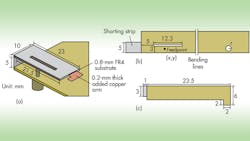This file type includes high resolution graphics and schematics when applicable.
The cost and size of the antenna structures needed to cover all modern telecommunications standards are major considerations for mobile handset manufacturers. Complex antenna arrays that incorporate GPS and multiple-input multiple-output (MIMO) functionality could provide significant performance benefits while meeting the cost and size demands for these handsets. Such a goal was sought by the research team composed of Hari Shankar Singh, Mayank Agarwal, Gaurav Kumar Pandey, and Manoj Kumar Meshram. They designed and tested a quad-band MIMO antenna array that covers the GPS-L1/Bluetooth/Wi-Fi/LTE2500/WiMAX/HIGHERLAN 1 frequency bands.
The antenna, which has a profile of 25 × 10 × 5.8 mm3, consists of two planar-inverted F-antennas (PIFAs). The isolation of the PIFA antennas was found to be better than -15 dB with a correlation coefficient lower than 0.015 between the antenna elements. To achieve such results, the team used Ansoft’s HFSS to optimize the geometric parameters of the antenna in conjunction with CST Microwave Studio.
The primary PIFA antennas are mirrors of each other and are thus mounted on the circuit-board corners. The antennas are configured for optimized functionality at 1.575 GHz. Because the optimization process increased the size of the antennas, a folding technique was used to minimize each antenna’s surface area. A rectangular slot was cut into the top surface of the PIFA to enable better voltage standing wave ratio (VSWR) in the higher-order mode at 5.1 GHz. The group claims that the antenna provides pattern diversity adequate for mobile communications and good isolation characteristics. See “A Quad-Band Compact Diversity Antenna for GPS L1/Wi-Fi/LTE2500/WiMAX/HIPERLAN1 Applications,” IEEE Antennas and Wireless Propagation Letters, Feb. 2014, p. 249.
This file type includes high resolution graphics and schematics when applicable.
About the Author
Jean-Jacques DeLisle
Jean-Jacques graduated from the Rochester Institute of Technology, where he completed his Master of Science in Electrical Engineering. In his studies, Jean-Jacques focused on Control Systems Design, Mixed-Signal IC Design, and RF Design. His research focus was in smart-sensor platform design for RF connector applications for the telecommunications industry. During his research, Jean-Jacques developed a passion for the field of RF/microwaves and expanded his knowledge by doing R&D for the telecommunications industry.


